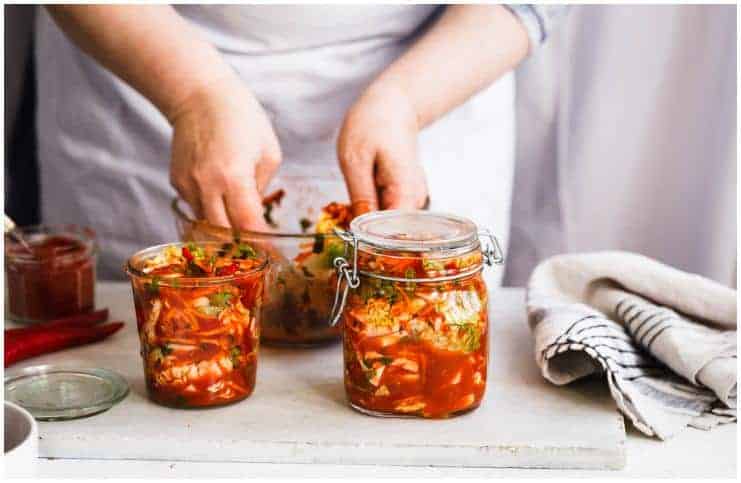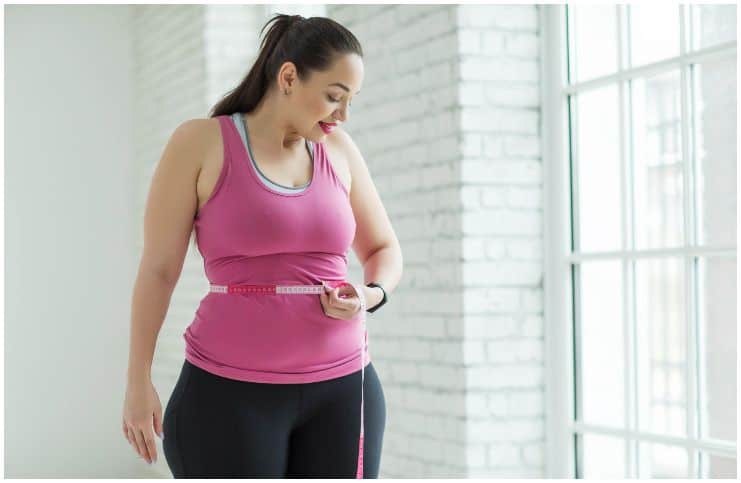How to Make Homemade Vegan Korean Kimchi – Gluten and Saturated Fat-Free Recipe:
Kimchi, a famous fermented vegetable Korean dish, is best described as a spicy, slightly sweet, fermented, or pickled cabbage, commonly served as a side dish.
There are hundreds of varieties, depending on the main vegetable ingredient used and the region or season in which they’re made.
The term ”kimchi” has been derived from the Korean word ”shimchae” which means ”salting of vegetables.” Later, after going through many phonetic changes, the term ”kimchi” came into the picture and has remained to date.
If you are new to kimchi, you may be repelled at first by its unique taste and strong smell. Once you get used to it, however, you will most likely become addicted.
In traditional preparations, it was stored underground in jars to keep cool during the summer months and unfrozen during the winter months.
Health Benefits
Important nutrients
It is made of different vegetables and contains a high concentration of dietary fiber, vitamin A, B1, B2, C, calcium, and iron, allicin (the cancer-fighting chemical in garlic), capsaicin (the active antioxidant component in chili peppers).
Some researchers say that it is great for fighting cancer, lowering cholesterol, anti-aging and for an immunity boost.
Good for digestion
It is a perfect food to promote digestion. It is a source of probiotics, that result from the process of fermentation involved in its preparation.
The process of fermentation, not only enhances the taste but also creates an essential bacteria, Lactobacillus, a type of bacteria that is required by the body to keep a healthy state of intestinal flora.
Weight loss
150 grams contains only 40 calories. Moreover, capsaicin – an active component found in chili peppers in this Korean dish, boosts the metabolism and improves the use of the excess energy in your body, thereby increasing weight loss.
In addition, the capsaicin in peppers acts as an anti-irritant.
Cleanses the body
Professor Miri Kim of the Food Nutrition Department at Chungnam National University established that the Chinese cabbage and radish found in this Korean food contain biochemicals such as sulfide (the inorganic anion of sulfur) and isocyanate, helpful in detoxifying heavy metals found in the kidney, small intestine, and liver.
Lowers bad cholesterol (LDL)
Replacing foods that are high in saturated fat with healthier options can lower LDL – blood cholesterol levels and improve lipid profiles. Saturated fats occur naturally in many foods.
The majority come mainly from animal sources, including meat, eggs, and dairy products. Kimchi, with its combination of garlic, fruits, scallions, and vegetables, works overtime to keep your arteries clean.
Ingredients
- 2-3 lbs./1 kg (1 head) organic Napa or green cabbage;
- 2 quarts/liters filtered water;
- 1 lb/ ½ kg organic daikon or Korean radish (about one 12 inch/50 cm length, 1-inch/3 cm diameter daikon);
- ½ cup/120 ml sea salt or kosher salt;
- 4 organic scallions;
- 1 tbsp./15 ml tamari (gluten-free);
- 1 (3-inch/13cm) hand organic ginger, about 40g peeled;
- ¼ cup/60 ml dried red pepper powder (gochugaru);
- 6-8 cloves (one bulb) organic garlic, about 60g peeled.
Method
#1 Combine all ingredients in a large bowl.
#2 Remove a few cups of this mixture and put it into a blender.
#3 Add enough filtered water to the mixture in your blender to make a ”brine” with the consistency of a thick juice. Blend well, and then add the brine back into the first mixture. Stir well.
#3 Pack the mixture down into a 1½ quart glass or stainless steel container. Use your fist, a potato masher, or a wooden dowel to pack veggies tightly.
#4 Fill the container almost full but leave about two inches of room at the top for veggies to expand.
#5 Roll up several cabbage leaves into a tight “log” and place them on top to fill the remaining two-inch space. Clamp the jar closed or screw on the airtight lid.
#6 Let veggies sit at about a 70-degree room temperature for at least 3 days (7 days is even better). Refrigerate to slow down fermentation.
Homemade vegan Korean kimchi cooking tips:
#1 Choose cabbages that are hard, heavy, and have densely packed leaves. The lighter, leafier varieties tend to turn into mush that doesn’t ferment well.
#2 You may have to experiment with the fermentation time that works for you. If it’s very warm, 24 hours may be all that it takes, if it’s cooler, then it will take longer. Some go for 5 days or even 10 days.
#3 The smell is a good indicator of the end of the fermentation process. If it smells pleasant to the nose and tangy, like the kimchi you’re used to trying, it’s probably ready to transfer to the refrigerator.
#4 Korean chili powder (gochugaru) is made from thin red peppers that are sun-dried on woven mats or strung together and hung from the eaves of thatch-roofed houses throughout the countryside.
Kimchi can be stored in the refrigerator for at least a month and even 3-4 months. You’ll know it’s gone bad if mold has formed or the smell is unpleasant or sour.
READ THIS NEXT:
Taro Poi Recipe – Traditional Hawaiian Food + Health Benefits & Precautions



I’m searching for something to help with linear morphea. I was diagnosed almost a year ago. There are small and large patches all over my body except for my hands and face. I have pain 24/7. On methotrexate, which isn’t helping at all. Any suggestions?